Communication is one of the most underrated skills in the preparedness world. We need communication for coordination, information, intelligence gathering, and not least of all human contact. Without a means for communication, our world shrinks to the range of our voice.
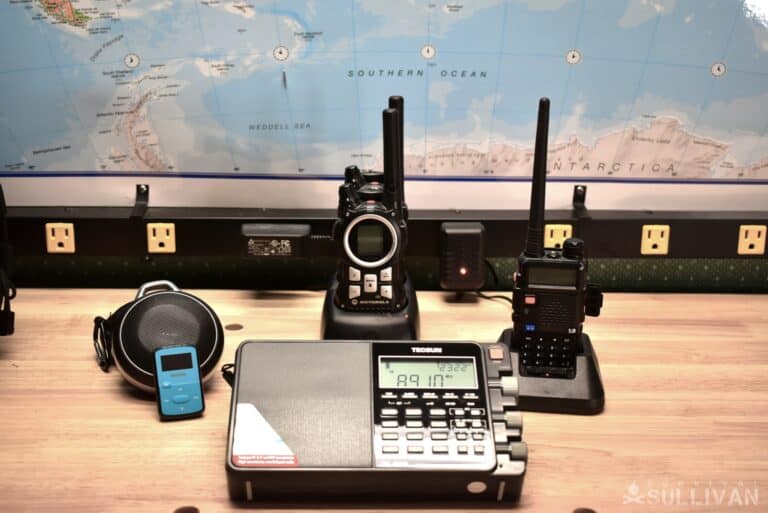
I once heard that without communication, anyone outside of walking distance will become someone you used to know. I think that sums the situation up perfectly.
The troublesome part of communication is how to get started and what gear to buy. Manufacturers describe emergency radios in a language all their own. This article will dispel a bit of that magic while getting you on the path to a well-designed emergency communications strategy.
Table of Contents
Why Communications?
Without a means for communication, the loudness of your voice, and the keenness of your hearing become your absolute limit to exchange information. Just like medical preparedness, it can be done. It’s just better with the correct tools.
We rely on communication every day. We call friends and family. We watch the news. We get weather reports. It’s all various forms of information collection and exchange.
During an emergency, the ability to communicate can be the difference between life and death. A weather report that warns of a worsening storm is as valuable as a news report that describes the progress of a riot.
When a disaster is over, the first instinct is to reach out to your loved ones to let them know you are ok. Beans, bullets, and bandages won’t do this for you.
During a disaster, you need every edge you can get. Communication gives you that edge. Emergency radios allow you to call for help. How many hikers could have been saved if they only had a radio and a known communication plan?
Main Prepper Radio Features
What to look for in a radio? First, there are several factors based around information gathering (e.g. listening) and two-way communication (e.g. talking). Other specifics will depend on your intended use.
Will you be on the move during a bug out? Do you plan on bugging out on foot or in a vehicle? Or will you be bugging in? You can also plan static location support from your bug out location as other teams make their way to you.
Listening
When listening, you have a few requirements to consider. Do you want to listen to public broadcast, or do you wish to go further?
The most common public communications are AM and FM radio broadcasts. In times of emergencies, radio stations will broadcast the most current information. In some situations, they must broadcast announcements from local, state, and federal agencies.
Intelligence collection can extend to non-commercial sources. Your plan must consider listening to local police, fire, EMS, and other services such as highway management and school transportation.
Broadcasting
A little obvious, but the opposite of listening is talking. To broadcast you need two items, a radio capable of transmitting, and someone to talk to.
The radio is easy. There are a multitude of radios that transmit. The real question is how far do you need to reach. Just around the property? There is a radio for that. Communicating to the moon and back (yes, it’s possible)? There is a radio for that. Determine your needs then select a radio.
If a prepper calls out in the woods, and there is no one to hear them, do they make a sound? You need a communications plan to ensure that someone is out there listening. It doesn’t have to be anything complicated. Your plan needs only indicate times and channels\frequencies that you will use to reach out.
Mobility
The next feature of your emergency radio selection is mobility. On the move, space is an issue. On foot, you need the absolute smallest and lightest tools for the job.
On a vehicle-based evacuation, you can afford a larger radio. When ensconced at a static location (e.g. home or bug-out location (BOL)), you can afford to use the fullest array of communication tools available.
Accessories
The last things to consider are any extra features that come with the radio. Several commercial emergency radios include additional frequencies (e.g. weather channels), hand crank chargers, and flashlights. Make a list of the priority accessories and evaluate radios by their inclusion or exclusion.
AM / FM Radios
The basic radio choice is an AM\FM radio. Limited to radio reception, they do give you access to public announcements from any radio station within range. Make a list of all the public AM and FM radio stations within 150 miles of your home, bug out route, and BOL.
Disclosure: This post has links to 3rd party websites, so I may get a commission if you buy through those links. Survival Sullivan is a participant in the Amazon Services LLC Associates Program. As an Amazon Associate, I earn from qualifying purchases. See my full disclosure for more.

Prunus J-05 AM / FM Radio
Not all scenarios require the smallest possible radio. Sometimes, you have the luxury of using a larger radio. In these cases, it pays off to use a table-top radio. Larger radios have longer antennas, larger batteries, and additional features (extra bands, digital readouts, sleep timers, etc.).
Sized for sitting on a desk or dashboard, the Prunus is not something you’ll want to add to your BOB. That being said, it’s great for static locations.
The large speaker allows the entire family to listen to any inbound information. This is also the first radio in our list that has a setting for NOAA weather broadcasts.
- ✅ Pros: Large antenna will bring in the weakest stations, wall and battery-powered
- ❌ Cons: Analog dial, doesn’t allow you to set exact frequencies
Commercial Emergency Radios
This next batch is specifically offered as “Emergency” radios. Most have multiple power sources, lights, and receive NOAA frequencies. A note for their use of solar and cranking.
You should not depend upon these as the primary power source. Yes, solar will charge the radio, but it may take days of full sun.
The hand crank may give you only one minute of listening for one minute of cranking. Use the crank charger to occupy the kiddos rather than depend on it for a full charge.

Kaito KA500
Kaito is known for its emergency radios. They incorporate features that are common to traditional emergency use. Most Kaito radios have redundant energy sources (wall power, battery, hand crank, and solar), multiple bands (AM\FM\Short-Wave (SW)\Weather), and are ruggedly built.
The Kaito KA500 is a very popular emergency radio that uses AA batteries, 5-volt, and wall power. It can also be crank charged and solar charged. It picks up AM\FM, NOAA, and SW frequencies. Finally, it has a flashlight if you find yourself in the dark, and a 5-volt charger if your phone needs a top-off.
- ✅ Pros: Full function
- ❌ Cons: Does not include a short-wave antenna, and does not include single sideband (SSB) for receiving HAM transmissions

FosPower Emergency Solar Hand Crank Radio
FosPower is another well-known manufacturer of emergency supplies. They manufacture several emergency tools from radios, to power banks, to survival blankets\bags. They have designed their radios to meet the needs of most emergencies.
The FosPower has a modest 2000 mAH internal battery that should be able to bring your cell phone up to 50%-75% when using it as a battery bank. The integrated light includes two modes. One for reading, and a bright mode to use as a traditional flashlight. It also pulls in AM\FM\SW frequencies.
- ✅ Pros: Can be charged by micro-USB (5v)
- ❌ Cons: At 2000 mAH, the internal battery could be bigger

Aiworth Emergency Solar Hand Crank Radio
Aiworth is a manufacturer of electronics, of which emergency radios fill a small niche. The Aiworth is a mid-sized and ruggedized emergency radio.
It covers AM\FM and NOAA frequencies and has an integrated light. It also has an SOS mode that emits a loud signal and flashes the light (SOS pattern). Oh, I can’t ignore the fact that it has a bottle opener.
With the weather radio support, the Aiworth has an alarm function. When set, the alarm will sound when severe weather is approaching. While not a feature, you want when maintaining a low profile, it will be valuable when you cannot simply check your weather app for an update.
- ✅ Pros: 4 power sources (solar, crank, AA batteries, micro-USB), SOS alert function
- ❌ Cons: Does not include SW frequencies
FRS / GMRS “Blister Pack” Radios
Blister pack radios… The ones where you can buy 2 or more sealed in a plastic blister pack. These are the first step in two-way communications.
While some have plenty of features, I must forewarn you about their advertised range. Regardless of what the package states, you will be lucky to get a mile or more of range.
The manufacturer’s report ranges based on absolute perfect conditions. They disregard small things like buildings, trees, and mountains. Armed with this information, read on.
FRS and GMRS are two different frequency sets. GMRS works over longer ranges (slightly) however it technically requires a license. FRS can be used without any license.

Motorola Talkabout T402
Motorola has several radios in this category. All are great choices for home, BOB, and BOL use. The T402s have the benefit of being water-resistant, not waterproof, but resistant. Don’t go swimming with one, but it’s OK to use them in the rain.
As these are FRS radios, use them without a license. Also, they have 22 channels and multiple privacy codes. Privacy codes either use a tone (that the radio detects then filters out) or digitally package your signal.
Note, there is nothing private about these. They are simply the way the radio filters out the conversation you belong to (via the code) vs all other conversations on the same frequency.
- ✅ Pros: Standard channels and privacy codes, programmed with weather radio frequencies
- ❌ Cons: Only two per pack–you will need more for a team plus backups

Midland 50 Channel GMRS
Midland, like Motorola, has many portable radios. They both manufacture radios across the entire spectrum of use. These include commercial two-way radios, CB radios, and blister pack walkie-talkies.
This model uses the GMRS frequency set and therefore requires a license. They also receive NOAA broadcasts. The privacy channels on the Midland ’50s give you over 3,000 possible combinations.
That’s a lot of areas to search to find your specific conversation. If you choose to use privacy codes when communicating, include them in your plan. Also include the exact steps required to set up your radios.
- ✅ Pros: Includes car charger and earbuds
- ❌ Cons: Not likely to reach the advertised 36-mile range

BaoFeng Two Way Long Range FRS / GMRS
These BaoFeng radios, more on the manufacturer later, support both FRS and GMRS frequencies. They support only 16 channels, which makes coordination easier.
Unlike most other radios in this section, these have a simple dial for channel selection and they don’t display the channel on an LCD screen. This means there is less to understand and less to break. Simply turn the dial and the audio prompt announces what channel you are on.
The battery allows for 8-12 hours of continuous use. They come with a charger for each radio. Their standby time is rated at 5-7 days. This is when the radio is on, but not receiving or transmitting. The radios recharge in about 5 hours. So plan accordingly. Have enough to cover all shifts with fully charged radios.
- ✅ Pros: Replaceable battery pack, purchase several, synthetic voice announcing the current channel
- ❌ Cons: Not waterproof or water-resistant

Gracioso AM / FM Portable Personal Radio
On foot, ounces equal pounds. Pounds equal pain. If you plan on traveling by foot and require a small AM\FM, full-featured radio, then “transistor” sized is the way to go.
The larger footprint supports a bigger (internal) antenna for better reception and a larger battery for better run times.
To increase battery life, use earphones. They draw less power and also allow you to listen to a louder volume without an audible footprint.
The Gracioso radio has several additional features, including a sleep function and an alarm. Don’t discount the need for an alarm! You may have to reverse your sleep cycle during a bugout and an alarm will be critical to getting up after sundown.
- ✅ Pros: Small, function-rich, has a speaker, and uses wired earphones
- ❌ Cons: Not rechargeable

SanDisk Clip JAM
During a bug out, every ounce counts. I’ve had the 50-pound bag, and it sucks. My current bag is still heavy, but I’ve kept weight where it counts. That area is not communications.
My bugout plans require listening to public broadcasts and communicating over short distances. This makes the SanDisk Clip JAM a perfect addition, and is why I settled on this radio for my bug out bag.
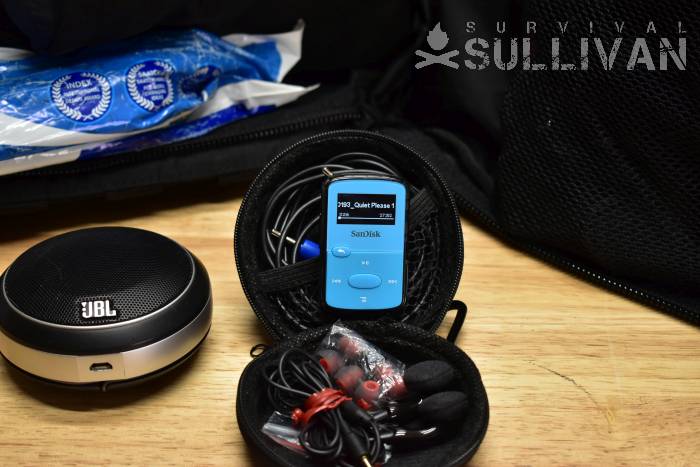
It’s small, rechargeable via a 5-volt battery, and has the benefit of playing MP3 files. In fact, that’s its primary purpose in my BOB. I have an extensive collection of old-time radio broadcasts on microSD cards.
These are my entertainment during long hikes and nights. That it also picks up FM stations is an added benefit. This radio is perfect for everyday carry (EDC) or BOB use. My BOB has a small list of all the FM radio stations in the area.
- ✅ Pros: Very small, plays music, podcasts, audiobooks on MicroSD card
- ❌ Cons: Only picks up FM radio stations, requires wired headphones
Citizen Band Emergency Radios
No, we’re not in the ’70s. CB radios are alive and well. The FCC limits FRS and GMRS radios to 2 watts of power for transmission. The FCC, however, allows 4 watts for CB, which amounts to an increased range.
An additional advantage of CB radios is the ability to change antennas. The longer the antenna the better the reception and transmission.

Uniden Pro401HH
These days, Uniden is probably better known for its radar detectors. That being said, they still are at the forefront of CB radio production. They have an impressive array of CBs from handheld to mobile. You can mount any mobile radio in a static location as long as you provide a power supply and an antenna.
This handheld CB radio is an impressive addition to a BOB when your bug out route takes you along highways or other popular roadways. Compact, high powered, and able to use an external antenna. Pack one in your BOB for additional range.
The Pro401HH comes with a set of rechargeable batteries but can also run on 9AA batteries if the rechargeable set runs low on power.
- ✅ Pros: Small form-factor, low and high-power settings to increase battery life or range
- ❌ Cons: Not waterproof or resistant, no option for earbud or microphone

Midland 1001LWX
Mobile CB radios can be both car and BOL mounted. There is little need these days for a complete base station that was the staple of the 70s.
The Midland 1001LWX is a mobile\car-mounted radio that uses 12-volt power and an external antenna. You can purchase an adapter that powers it from a cigarette lighter. This allows you to use the CB with no permanent mounting. If you choose to mount it permanently, it comes with a mounting bracket that includes a place to hang your microphone.
The Midland has a feature that locates and receives your local NOAA weather station. This allows you to listen quickly to NOAA weather forecasts without the need for a second radio.
- ✅ Pros: Adjustable gain (amplification of received signals), weather scanning functions
- ❌ Cons: Requires 12-volt power source–not portable

Cobra 29XL
Cobra joins Uniden and Midland as the most well-known CB radio manufacturers. The Cobra 29LX is a feature-rich radio that is suitable for both mobile and base station use. The cobra supports all 40 bands, and has a 10-channel memory for scanning. Load your priority channels and let the radio cycle these frequencies listening for chatter.
The 29XL is also loaded with features that make it an ideal radio for a static location. These include NOAA channels and emergency alert, clock / timer / alarm, long microphone cord, and a public address (PA) speaker mode.
- ✅ Pros: Adjustable LCD color, channel scan feature
- ❌ Cons: Antenna not included
HAM Handi-Talkies
HAM handheld radios (handi-talkies) can have significantly more power than any of the other radios we have already discussed. Second, they can use replaceable antennas. A good antenna with quality placement will increase your range dramatically. A handi-talkie can fit in your EDC or BOB and have room for an improved antenna.
Finally, most local and state agencies use 2m and 75cm frequencies for communication. With a HAM radio you can listen to your school, highway, EMS, fire, and police chatter.
Note, some use digital or encrypted radios so you can’t hear what they are saying, but you will know that they are talking. Check out for a list of frequencies in your zip code.

BaoFeng UV-5R
The venerable BaoFeng UV-5R. As soon as these hit the market, preppers fell in love with this inexpensive route to distant, two-way communications.
This radio is the reason I got into HAM radio for my emergency preparations. For less than I could purchase a battery for some “better-known brands”.
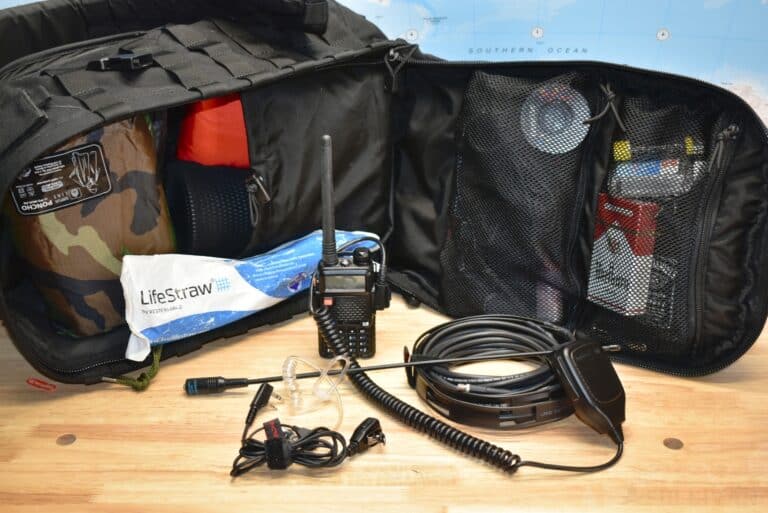
I bought 4 radios and several improved antennas. As for accessories, there are more accessories than I can list in a single article.
Prepper authors have referenced BaoFengs in articles more than any other radio than I know. The price is the primary reason. While they aren’t the most rugged, just buy four. If you drop and shatter one, you’ll have a ready spare.
- ✅ Pros: 2m and 75cm bands, many inexpensive accessories available online
- ❌ Cons: Difficult to program (get a cable and CHIRP)
Mobile HAM Emergency Radios
Mobile HAM radios step up the power in their larger form factor. You can easily get 50 watts or up to 100 watts. With that power, you can achieve the fullest extent of 2m and 75cm line-of-sight capabilities. The higher your antenna, the better your range. Mount these radios either in a vehicle, or at your BOL.

BTECH Mobile UV-50X2
BTECH is the U.S. distributor of BaoFeng radios. They pack this small mobile radio with features for an incredibly inexpensive price. Mobile ham fills a niche for the on the road prepper.
You can practice your skills during your daily commute. If you are not the talkative type, use this time to collect information on the active repeaters and the local personalities.
This BTECH is a standard no-frills radio. It covers both 2m, and 75cm, has a speaker-mic, and can monitor multiple frequencies. For a basic mobile rig, there isn’t too much else that is needed.
- ✅ Pros: Dual-band, frequency scanning
- ❌ Cons: It does not include a programming cable
Base Stations
Now we get into the real ability to reach out and touch someone. Base stations break you free from size, weight, and power limitations. You are limited only by how much you want to learn and buy.
With a base station you may be required to purchase several accessories including power supply, antenna tuner, external speaker, improved microphone, and not the least one or more quality antennas.

Tecsun PL880
I got into HAM High-Frequency (HF) with this little radio. I’ve used one for several years to learn frequency bands, how to decode digital modes, and the benefits of a long wire antenna. Whenever societal disruption flares up, I fire up the Tecsun and monitor a series of preset frequencies.
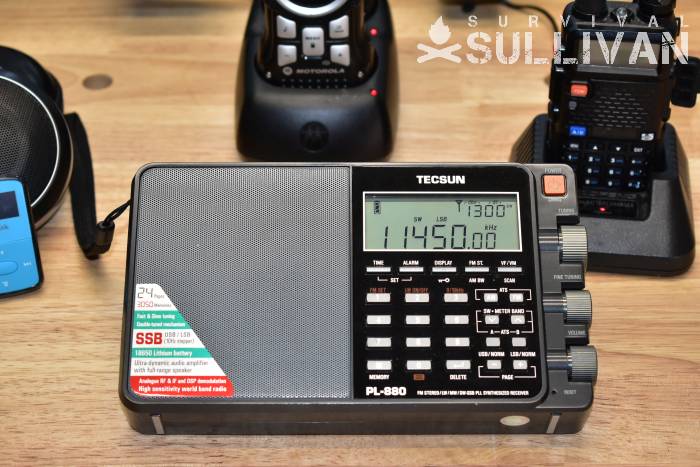
From my experience, the PL880 is a great radio if you want to dip your toes into HF HAM communications without the license or the cost. It covers the same frequencies that HAM operators use and has SSB (a transmission mode used by HAM radios).
That’s where the information will flow. With a “long wire” antenna and a bit of knowledge, you can listen around the world.
- ✅ Pros: Small, all HAM bands (with SSB)
- ❌ Cons: No transmission capabilities
ICOM IC-718
This is where we get serious. There is no better way to reach out and touch the world than a quality HAM HF radio. With this class of radio, you can exchange information with your state, region, country, and world. Be forewarned, there is a lot to learn for proper and safe operation.
The IC-718 is not as fancy as other full-featured HF rigs, but for a basic rig, it does everything you need to talk around the block or around the world. The IC-718 covers 10 meters through 160 meters, has several digital signal processing (DSP) modes for cleaning up signals, and transmits at a maximum of 100 watts.
- ✅ Pros: Cheap (for an HF base station)
- ❌ Cons: Lots of knowledge and accessories required (that’s another full article)
Communication Plans
As I mentioned earlier, there are two parts to the communications equation. The tool and the listener. We just talked about the tools. Now it’s time to ensure that you have someone to talk to.
The frequency spectrum is vast. Spend a Friday night zipping through the AM and FM dial, then double or triple that when you get into SW frequencies. Looking for someone to talk to is like searching for a needle in a haystack. Possible, but daunting.
A communications plan restricts the entirety of the spectrum to a few frequencies or channels and times. This makes communication much more manageable.
When you adopt a set of emergency radios, write down your plan. This can be as simple as “Every 15 minutes I will listen to or broadcast on channel 3 for 5 minutes.” Like I said, nothing complicated.
If you wish to get more full-featured, I recommend looking up the group AMRRON. Their Signals Operating Instructions (SOI) is the perfect example of a complete COMS plan for a medium to large group.
If you are on a weekend hike or heading into your BOL during the end times, having a communication plan will make sure that someone is at the other end of the line to answer your call.
Concluding Communications
Communications are not it the top three of prepper needs. Communication is not as sexy as beans, bullets, or bandaids. However, they a part of a well-thought-out and balanced plan.
If you are only interested in listening to the emergency broadcast system, a simple AM / FM radio is fine. If you have larger aspirations, get your HAM license, and invest in a set of handi-talkies. Or even better, become your group’s communication specialist. With the correct gear, you can get information from around the globe.
Take a few minutes and do an honest evaluation of the status of your current communications abilities. If you can take a hike and keep in contact with your spouse or friends, then you are well-positioned. If not, it’s time to step up your game a little and fill out this necessary skill set!
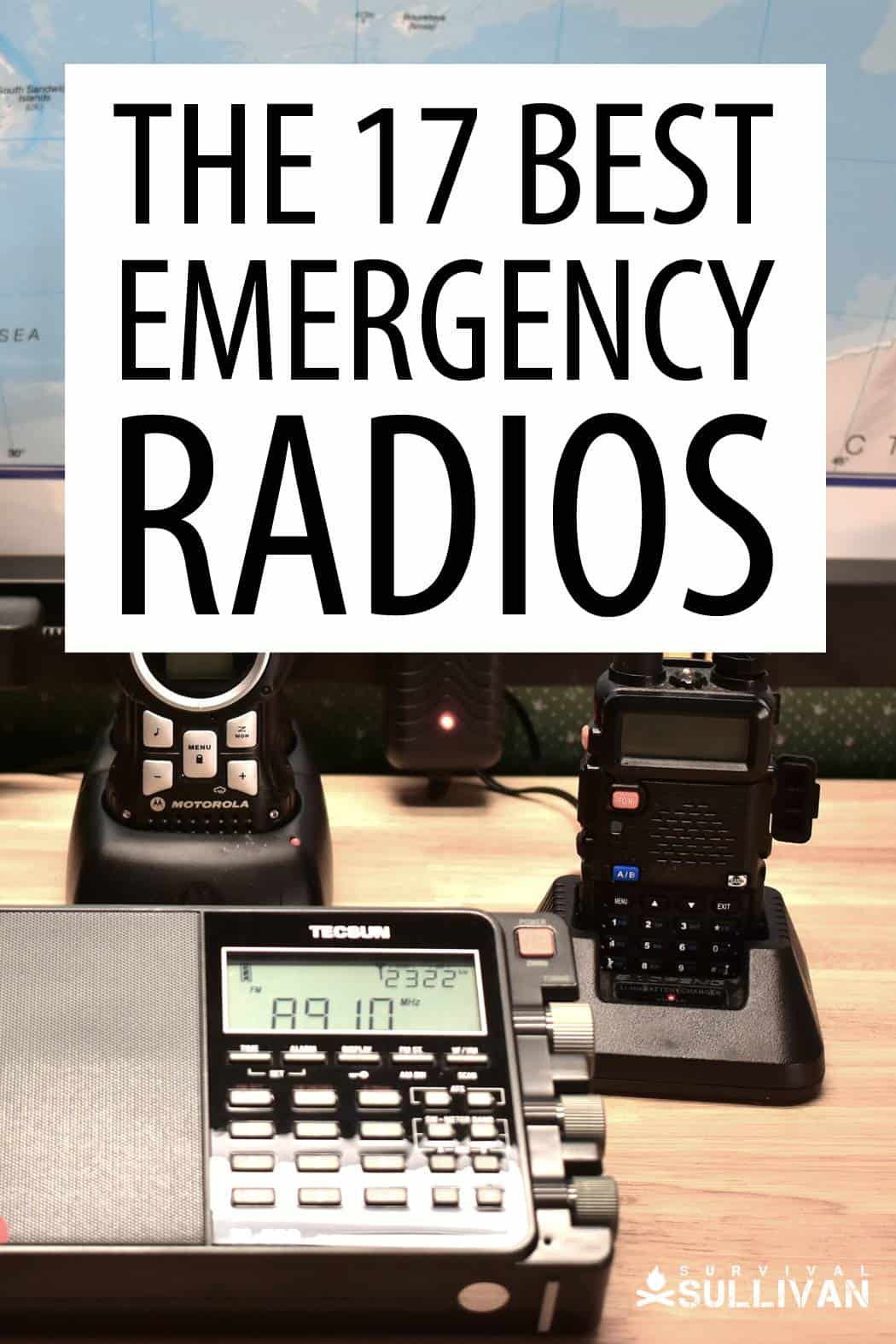

My passion is empowering people with the knowledge to prepare for personal, local, and regional emergencies. I went to school for engineering and computer science and spend my days in the security industry.

I have two BaoFeng UV-5R radios, however, I have no idea how to tune in to any HAM stations. I can tune into the NOAA weather, but have no idea on tuning into actual HAM channels. Anyone know how to do the basics?
They can be programmed manually but it’s a pain. The best way is to get the free CHIRP software, and then upload frequencies into it purchased from radioreference.com. You will need to get a programming cable to connect your computer to the radio. The CHIRP software can load the frequencies into your radio. There are YouTube videos that walk you through step by step.
I’ve not gone through the Technicial licensing, but I’ve purchased 4 BaoFeng UV82HP’s (FYI: the company’s now called PoFung). The higher power feature is why a license is required.
I want to get licensed, but at the same time, if SHTF, licenses and regulations will be the last of anyone’s worries. The only reason for licenses is government overreach.